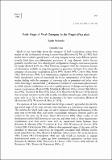Por favor, use este identificador para citar o enlazar a este item:
http://hdl.handle.net/10261/59404COMPARTIR / EXPORTAR:
 SHARE SHARE
 CORE
BASE CORE
BASE
|
|
| Visualizar otros formatos: MARC | Dublin Core | RDF | ORE | MODS | METS | DIDL | DATACITE | |

| Título: | Early stages of vocal ontogeny in the magpie (Pica pica) |
Autor: | Redondo, T. CSIC ORCID | Fecha de publicación: | 1991 | Editor: | Blackwell Publishing | Citación: | JOURNAL OF ORNITHOLOGY 132: 145- 163 (1991) | Resumen: | The vocal repertoire of magpie (Pica pica) chicks consists of six calls: Begging Trill (BT), Soft Whistle (SW), Begging Scream (BS), Alarm Call (AC), Distress Call (DC) and Brief Contact Note (BCN). Both BT and SW have a tonal structure and their occurrence is restricted to the nestling period. At fledging, there is a gradual change from BT into BS and a sudden appearance of harsh calls similar to those of adult birds (AC, DC, BCN), without evident transitional forms with preceding tonal calls. Both the existence and the structural design of calls seem to be adapted for providing nestlings with immediate benefits linked to the two major chapters of allocation of parental care. Emission rates of BT increase with hunger motivation under laboratory conditions. Their structure suggests that they are easily located but liable to suffer from environmental degradation. BS of fledglings may be more resistant to degradation, a trait which may facilitate the identification by parents of their own offspring. Both AC and DC attract parents to defend the nest against potential predators, and their structure make them to be easily located and detectable at long distances. BCN are given by fledglings during bouts of locomotory activity (exploration and play) and they probably help in maintaining the cohesion of the group under conditions of poor visibility. In accordance, this call may be fairly located at short distances. The function of SW was unclear. It is given during periods of nestling inactivity between begging bouts, and could be easily elicited by tactile and auditory stimuli. After laboratory experiments, it is concluded that SW serve to indicate parents that nestlings are in good condition, hence to benefit from the parental willingness to invest in a brood with high prospects of survival. Since (i) there is a widespread lack of continuity in the development of adult vocalizations starting from nestling calls, and (ii) nestling calls seem to have evolved to provide birds with benefits in the short-term, these facts argue against the prevailing idea that the main function of calls early in ontogeny is to act as precursors of adult vocalizations. © 1991 Verlag der Deutschen Ornithologen-Gesellschaft. | URI: | http://hdl.handle.net/10261/59404 | DOI: | 10.1007/BF01647274 | Identificadores: | doi: 10.1007/BF01647274 issn: 0021-8375 |
| Aparece en las colecciones: | (EBD) Artículos |
Ficheros en este ítem:
| Fichero | Descripción | Tamaño | Formato | |
|---|---|---|---|---|
| redondo.pdf | 1,17 MB | Adobe PDF |  Visualizar/Abrir |
CORE Recommender
SCOPUSTM
Citations
20
checked on 18-abr-2024
WEB OF SCIENCETM
Citations
17
checked on 22-feb-2024
Page view(s)
330
checked on 22-abr-2024
Download(s)
435
checked on 22-abr-2024
Google ScholarTM
Check
Altmetric
Altmetric
NOTA: Los ítems de Digital.CSIC están protegidos por copyright, con todos los derechos reservados, a menos que se indique lo contrario.
